The Hematology Analyzer Market is estimated to be valued at USD 2.7 billion in 2025 and is projected to reach USD 5.5 billion by 2035, registering a compound annual growth rate (CAGR) of 7.4% over the forecast period.
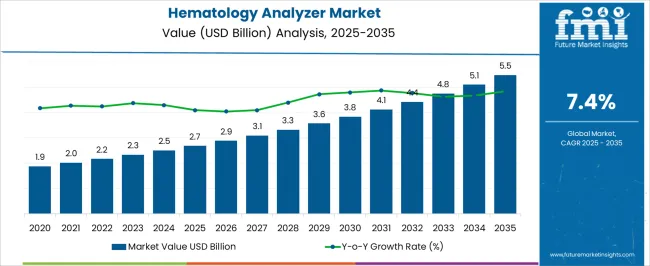
| Metric | Value |
|---|---|
| Hematology Analyzer Market Estimated Value in (2025 E) | USD 2.7 billion |
| Hematology Analyzer Market Forecast Value in (2035 F) | USD 5.5 billion |
| Forecast CAGR (2025 to 2035) | 7.4% |
The Hematology Analyzer market is experiencing steady growth driven by the increasing demand for efficient, automated blood testing and diagnostics in clinical and research settings. The market is being influenced by rising prevalence of blood-related disorders, the need for rapid and accurate hematological testing, and the ongoing trend of laboratory automation.
Advancements in analyzer technology, such as multi-parameter testing, improved detection capabilities, and software-enabled data management, are enhancing operational efficiency and diagnostic accuracy. Investment in healthcare infrastructure and the expansion of clinical laboratories are further supporting market growth.
Increasing awareness of early detection and preventive healthcare, particularly in emerging markets, is also contributing to the adoption of hematology analyzers The ongoing shift toward integrated diagnostic solutions that offer rapid, reliable, and scalable testing continues to shape the market’s future outlook, providing opportunities for both incremental improvements in analyzer capabilities and adoption in a wider range of healthcare facilities.
The hematology analyzer market is segmented by number of parameters, end-use industries, and geographic regions. By number of parameters, hematology analyzer market is divided into Hematology Analyzers Up To 10 Parameters, Hematology Analyzers From 10-30 Parameters, and Hematology Analyzers Above 30 Parameters. In terms of end-use industries, hematology analyzer market is classified into Hematology Analyzers For Clinical Laboratories and Hematology Analyzers For Research Laboratories. Regionally, the hematology analyzer industry is classified into North America, Latin America, Western Europe, Eastern Europe, Balkan & Baltic Countries, Russia & Belarus, Central Asia, East Asia, South Asia & Pacific, and the Middle East & Africa.
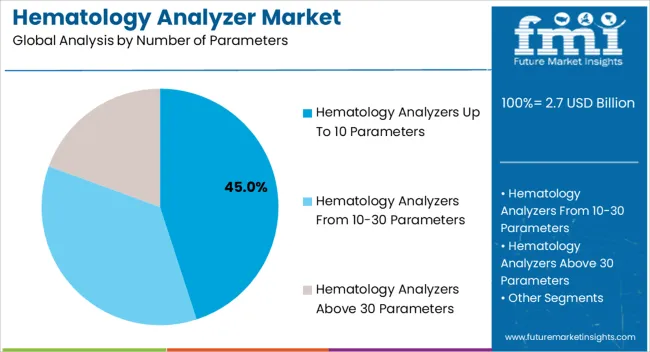
Hematology analyzers with up to 10 parameters are expected to account for 45.00% of the market revenue in 2025, making this the leading segment by number of parameters. This dominance is being attributed to their balance of performance and cost-effectiveness, which allows widespread deployment in hospitals, small clinics, and point-of-care settings. The compact design and lower maintenance requirements have facilitated adoption in facilities with limited laboratory infrastructure.
These analyzers are highly favored for routine blood tests, offering reliable results with moderate throughput, making them suitable for high-volume testing environments. The growth of this segment has been further supported by the increasing need for standardized hematology testing and automation in diagnostic workflows.
Furthermore, their capability to integrate with laboratory information systems enhances data management and workflow efficiency, contributing to operational scalability The combination of affordability, reliability, and automation potential continues to reinforce the segment’s leading position in the market.
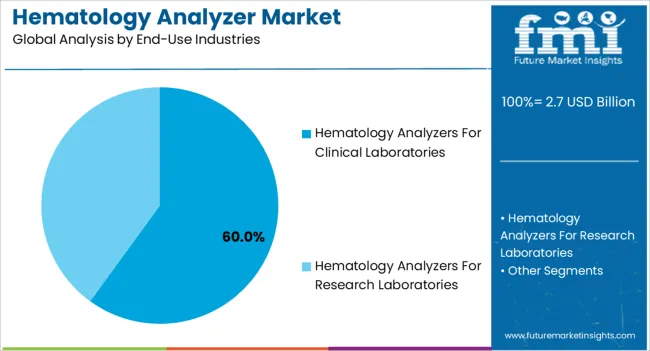
Hematology analyzers for clinical laboratories are projected to hold 60.00% of the market revenue in 2025, establishing this segment as the largest by end-use industry. This leadership has been driven by the expanding number of clinical laboratories globally and the growing emphasis on laboratory automation to increase testing throughput and accuracy.
These analyzers are highly valued for their ability to perform multi-parameter testing, provide precise results, and handle high sample volumes efficiently, making them indispensable in hospital laboratories and centralized diagnostic centers. The segment’s growth has been further reinforced by rising patient volumes, increased laboratory accreditation standards, and the adoption of integrated software solutions for data management.
Clinical laboratories increasingly rely on these analyzers to reduce manual intervention, improve turnaround times, and maintain high standards of quality control As healthcare providers continue to prioritize operational efficiency, diagnostic accuracy, and compliance with laboratory regulations, the clinical laboratory segment is expected to sustain its market leadership and support overall market expansion.
The recent consumer trends of the hematology analyzer market suggest that the industry involves advancements in technology. Continuous innovations in analyzers are enhancing accuracy and efficiency, driving demand.
The adoption of artificial intelligence (AI) and machine learning (ML) in such devices represents a crucial trend, allowing for more precise diagnostics and predictive analytics.
Another significant trend includes the integration of automation in hematology laboratories. Automation reduces manual errors, speeds up processes, and allows for high throughput of samples, making laboratory operations more efficient. This trend is particularly relevant as laboratories strive to handle increasing sample volumes.
The ongoing improvements in the technology, such as multi-parameter testing and advanced data management systems, are propelling the industry’s growth. Such technological advancements enhance the functionality and user-friendliness of such analyzers, making such devices more appealing to healthcare providers.
Rising awareness about early disease diagnosis and prevention acts as another driver. Patients and healthcare providers are increasingly recognizing the importance of early detection of blood-related disorders, spurring demand for regular hematology testing and thereby driving the competitive landscape for the hematology analyzer industry.
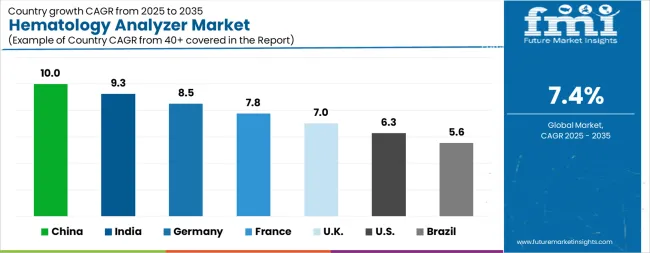
| Country | CAGR |
|---|---|
| China | 10.0% |
| India | 9.3% |
| Germany | 8.5% |
| France | 7.8% |
| UK | 7.0% |
| USA | 6.3% |
| Brazil | 5.6% |
| China | 7.8% |
| India | 7.3% |
| Germany | 6.7% |
| France | 6.1% |
| UK | 5.5% |
| USA | 4.9% |
| Brazil | 4.4% |
The Hematology Analyzer Market is expected to register a CAGR of 7.4% during the forecast period, exhibiting varied country level momentum. China leads with the highest CAGR of 10.0%, followed by India at 9.3%. Developed markets such as Germany, France, and the UK continue to expand steadily, while the USA is likely to grow at consistent rates. Brazil posts the lowest CAGR at 4.4%, yet still underscores a broadly positive trajectory for the global Hematology Analyzer Market. In 2024, Germany held a dominant revenue in the Western Europe market and is expected to grow with a CAGR of 8.5%. The USA Hematology Analyzer Market is estimated to be valued at USD 946.5 million in 2025 and is anticipated to reach a valuation of USD 1.7 billion by 2035. Sales are projected to rise at a CAGR of 6.3% over the forecast period between 2025 and 2035. While Japan and South Korea markets are estimated to be valued at USD 122.5 million and USD 74.0 million respectively in 2025.
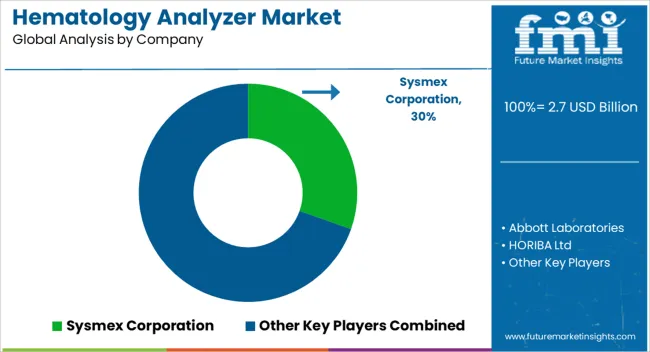
| Item | Value |
|---|---|
| Quantitative Units | USD 2.7 Billion |
| Number of Parameters | Hematology Analyzers Up To 10 Parameters, Hematology Analyzers From 10-30 Parameters, and Hematology Analyzers Above 30 Parameters |
| End-Use Industries | Hematology Analyzers For Clinical Laboratories and Hematology Analyzers For Research Laboratories |
| Regions Covered | North America, Europe, Asia-Pacific, Latin America, Middle East & Africa |
| Country Covered | United States, Canada, Germany, France, United Kingdom, China, Japan, India, Brazil, South Africa |
| Key Companies Profiled | Sysmex Corporation, Abbott Laboratories, HORIBA Ltd, Siemens Healthineers, and Danaher Corporation |
The global hematology analyzer market is estimated to be valued at USD 2.7 billion in 2025.
The market size for the hematology analyzer market is projected to reach USD 5.5 billion by 2035.
The hematology analyzer market is expected to grow at a 7.4% CAGR between 2025 and 2035.
The key product types in hematology analyzer market are hematology analyzers up to 10 parameters, hematology analyzers from 10-30 parameters and hematology analyzers above 30 parameters.
In terms of end-use industries, hematology analyzers for clinical laboratories segment to command 60.0% share in the hematology analyzer market in 2025.






Our Research Products

The "Full Research Suite" delivers actionable market intel, deep dives on markets or technologies, so clients act faster, cut risk, and unlock growth.

The Leaderboard benchmarks and ranks top vendors, classifying them as Established Leaders, Leading Challengers, or Disruptors & Challengers.

Locates where complements amplify value and substitutes erode it, forecasting net impact by horizon

We deliver granular, decision-grade intel: market sizing, 5-year forecasts, pricing, adoption, usage, revenue, and operational KPIs—plus competitor tracking, regulation, and value chains—across 60 countries broadly.

Spot the shifts before they hit your P&L. We track inflection points, adoption curves, pricing moves, and ecosystem plays to show where demand is heading, why it is changing, and what to do next across high-growth markets and disruptive tech

Real-time reads of user behavior. We track shifting priorities, perceptions of today’s and next-gen services, and provider experience, then pace how fast tech moves from trial to adoption, blending buyer, consumer, and channel inputs with social signals (#WhySwitch, #UX).

Partner with our analyst team to build a custom report designed around your business priorities. From analysing market trends to assessing competitors or crafting bespoke datasets, we tailor insights to your needs.
Supplier Intelligence
Discovery & Profiling
Capacity & Footprint
Performance & Risk
Compliance & Governance
Commercial Readiness
Who Supplies Whom
Scorecards & Shortlists
Playbooks & Docs
Category Intelligence
Definition & Scope
Demand & Use Cases
Cost Drivers
Market Structure
Supply Chain Map
Trade & Policy
Operating Norms
Deliverables
Buyer Intelligence
Account Basics
Spend & Scope
Procurement Model
Vendor Requirements
Terms & Policies
Entry Strategy
Pain Points & Triggers
Outputs
Pricing Analysis
Benchmarks
Trends
Should-Cost
Indexation
Landed Cost
Commercial Terms
Deliverables
Brand Analysis
Positioning & Value Prop
Share & Presence
Customer Evidence
Go-to-Market
Digital & Reputation
Compliance & Trust
KPIs & Gaps
Outputs
Full Research Suite comprises of:
Market outlook & trends analysis
Interviews & case studies
Strategic recommendations
Vendor profiles & capabilities analysis
5-year forecasts
8 regions and 60+ country-level data splits
Market segment data splits
12 months of continuous data updates
DELIVERED AS:
PDF EXCEL ONLINE
Hematology Analyzer And Reagents Market
Hematology Diagnostics Market Trends and Forecast 2025 to 2035
TOC Analyzer Market Size and Share Forecast Outlook 2025 to 2035
ESR Analyzer Market Analysis - Size, Share, and Forecast 2025 to 2035
XRF Analyzer Market Growth – Trends & Forecast 2019-2027
Lens Analyzer Market Size and Share Forecast Outlook 2025 to 2035
Fuel Analyzer Market
Solar Analyzer Market Size and Share Forecast Outlook 2025 to 2035
Boron Analyzer Market Size and Share Forecast Outlook 2025 to 2035
Metal Analyzers Market Size and Share Forecast Outlook 2025 to 2035
Power Analyzers Market
Logic Analyzer Market
Urine Analyzers Market
Ozone Analyzer Market
Breath Analyzer Market Size and Share Forecast Outlook 2025 to 2035
Signal Analyzer Market Size and Share Forecast Outlook 2025 to 2035
Grease Analyzer Market Growth - Trends & Forecast 2025 to 2035
Silica Analyzers Market
Genetic Analyzers Market Size and Share Forecast Outlook 2025 to 2035
Albumin Analyzers Market Size and Share Forecast Outlook 2025 to 2035

Thank you!
You will receive an email from our Business Development Manager. Please be sure to check your SPAM/JUNK folder too.
Chat With
MaRIA